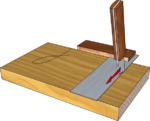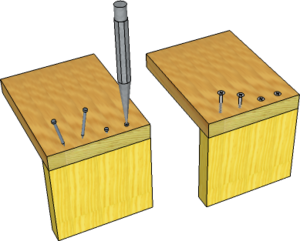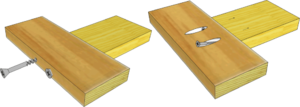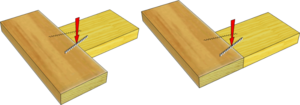Butt Joint: Difference between revisions
From DT Online
mNo edit summary |
(Added links) |
||
| Line 5: | Line 5: | ||
<span style="color: green">'''Note:''' | <span style="color: green">'''Note:''' | ||
When used to widen boards, '''Butt Joints''' are quite often simply glued and this is known as a ''' | When used to widen boards, '''Butt Joints''' are quite often simply glued and this is known as a '''[[WideningJoint|Rubbed Joint]]'''. | ||
</span> | </span> | ||
<div style="clear: both;"></div> | <div style="clear: both;"></div> | ||
| Line 14: | Line 14: | ||
---- | ---- | ||
<span style="color: red">'''Safety Point!''' | <span style="color: red">'''Safety Point!''' | ||
Students may only use a '''Chop Saw''' or '''Radial Arm Saw''' when they have been trained and assessed and the assessment shows that they are competent, and are under appropriate supervision of specifically trained staff. | Students may only use a '''[[Chop Saw]]''' or '''[[Radial Arm Saw]]''' when they have been trained and assessed and the assessment shows that they are competent, and are under appropriate supervision of specifically trained staff. | ||
</span> | </span> | ||
---- | ---- | ||
| Line 39: | Line 39: | ||
---- | ---- | ||
<span style="color: green">'''Note:''' | <span style="color: green">'''Note:''' | ||
Additionally '''[[Mitre Joint|Mitre Joints]]''' and some '''[[Widening Joints]]''' can be categorised as '''Butt Joints''' and, as with all others, can also be reinforced with '''[[Dowel Joint|Dowels]]''', '''[[Knock Down Fittings, Brackets and Plates|Knock-Down Fittings]]''', '''[[Biscuit Joint|Biscuits]]''' and '''[[Keys, Tongues and Slip Feathers|Keys]]''', '''[[Keys, Tongues and Slip Feathers|Tongues]]''' or '''[[Keys, Tongues and Slip Feathers|Slip Feathers]]'''. | Additionally '''[[Mitre Joint|Mitre Joints]]''' and some '''[[Widening Joint|Widening Joints]]''' can be categorised as '''Butt Joints''' and, as with all others, can also be reinforced with '''[[Dowel Joint|Dowels]]''', '''[[Knock Down Fittings, Brackets and Plates|Knock-Down Fittings]]''', '''[[Biscuit Joint|Biscuits]]''' and '''[[Keys, Tongues and Slip Feathers|Keys]]''', '''[[Keys, Tongues and Slip Feathers|Tongues]]''' or '''[[Keys, Tongues and Slip Feathers|Slip Feathers]]'''. | ||
</span> | </span> | ||
---- | ---- | ||
Revision as of 20:14, 7 February 2016
A Butt Joint is a simple coming together of two edges or faces. The joints can be fixed by simply gluing but more often is reinforced or strengthened before doing so. Butt Joints can be used to widen boards, make frames and create carcasses.
Note:
When used to widen boards, Butt Joints are quite often simply glued and this is known as a Rubbed Joint.
It is important to ensure that the ends of timber forming the joint are cut accurately and Square. This can be achieved off the saw if care is taken using a Tenon Saw and a Mitre Box for example. Alternatively a Precision Mitre Saw or Radial Arm Saw will produce more predictable results. In all cases, scribing the joint lines with a Marking Knife will help to ensure clean edges at the joint face.
Safety Point! Students may only use a Chop Saw or Radial Arm Saw when they have been trained and assessed and the assessment shows that they are competent, and are under appropriate supervision of specifically trained staff.
Reinforcing Butt Joints
- Nails and Screws
The most common way to reinforce a Butt Joint is simply to nail or screw the two pieces together.
Note:
Nails should be angled or 'Dovetailed' for additional grip and screws should be chosen which are twice the length and a thinner gauge when screwing into End Grain
Where it is not possible to screw directly through one part of the joint to the other (e.g. need to conceal screw heads or lack of access), screws can be sunk into 'Pockets'. These are holes drilled at an angle to the work surface to Counterbore the screw head as shown.
These provide a low cost and quick means of joining together a Butt Jointed frame. They are suitable for coarse joinery work and for assembling frames which are later skinned with Ply, Hardboard, or MDF for example.
Note: Additionally Mitre Joints and some Widening Joints can be categorised as Butt Joints and, as with all others, can also be reinforced with Dowels, Knock-Down Fittings, Biscuits and Keys, Tongues or Slip Feathers.





